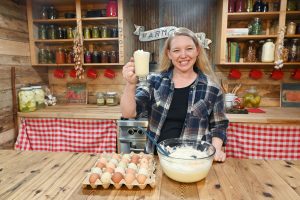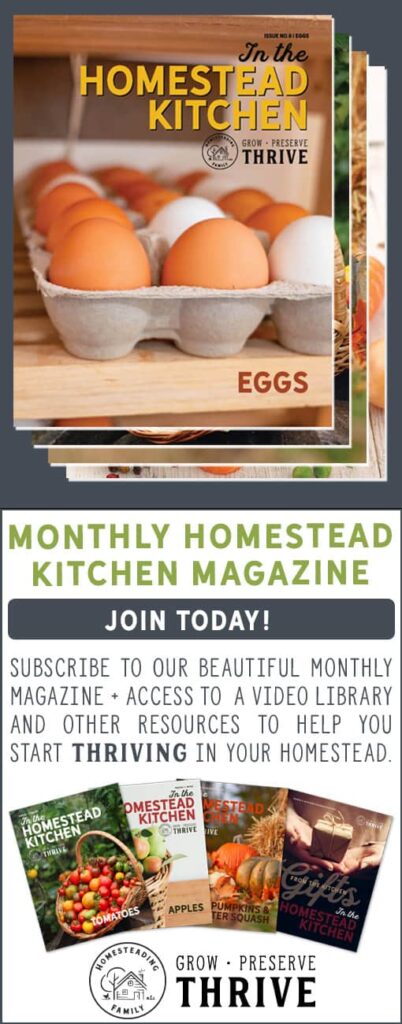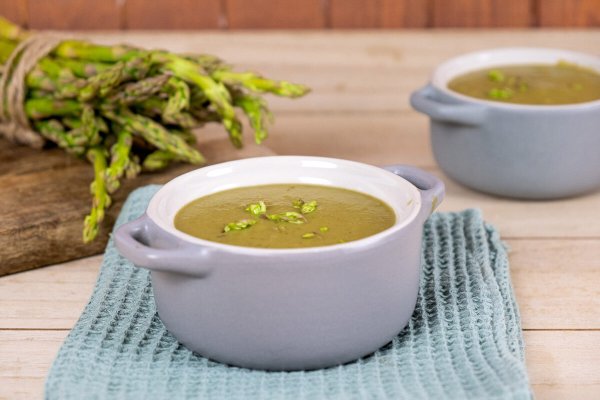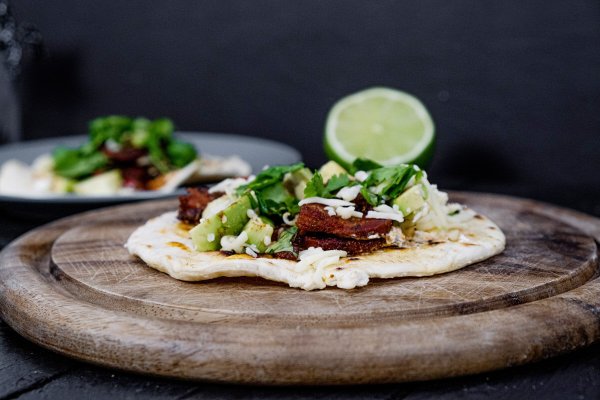Don’t overlook these important plants! We’re discussing what are perennials and why they’re an important aspect of the homestead. Growing perennial plants on the homestead is our greatest form or resiliency when it comes to food production.
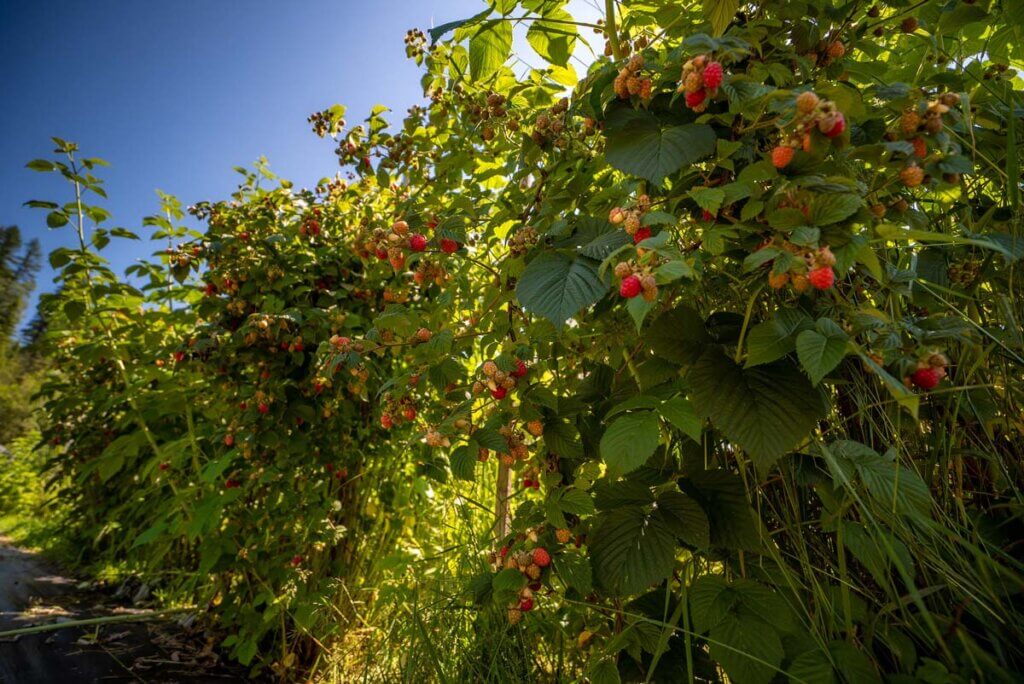
What Are Perennials?
Perennials are plants that you don’t have to plant every single year. They come back over and over again from the same root stalk. Depending on your growing zone, they’ll either be evergreen, where they continue to grow year-round, or they’ll die back to the ground each year and grow back from the same root stalk.
This is opposed to an annual that grows up every year and releases seed. The following year, that plant grows back from the seed, and this continues each year.
What Are Perennial Plants?
There are countless varieties of perennial plants out there. Many are ornamental plants and flowers that look beautiful in your yard, but in this blog post we’ll be discussing food and medicine-specific perennials.
Why Grow Perennials?
We have a goal of making life easier for ourselves in the future. When you plant perennial plants and get them established, you’re creating food security for your future.
Plant Once, Grow Forever
Take an apple tree, for example. If you plant a baby apple tree and tend to that tree for multiple years, that tree will continue to provide fruit for your family for years to come. This is in contrast to something like a tomato seed that you plant once and get fruit for one season. The following year, if you want tomatoes, you have to replant the seeds and tend to the harvest.
By planning out your perennial food garden, you can grow a well-rounded supply from various plants. Perennials include fruit trees, berry bushes, vegetables, nut trees and even medicinal herbs and flowers.
HOA Rules
Something else to consider, especially those living in areas with HOAs that don’t allow for a vegetable garden, is that there are many perennial food-producing plants that actually look more ornamental than they do food.
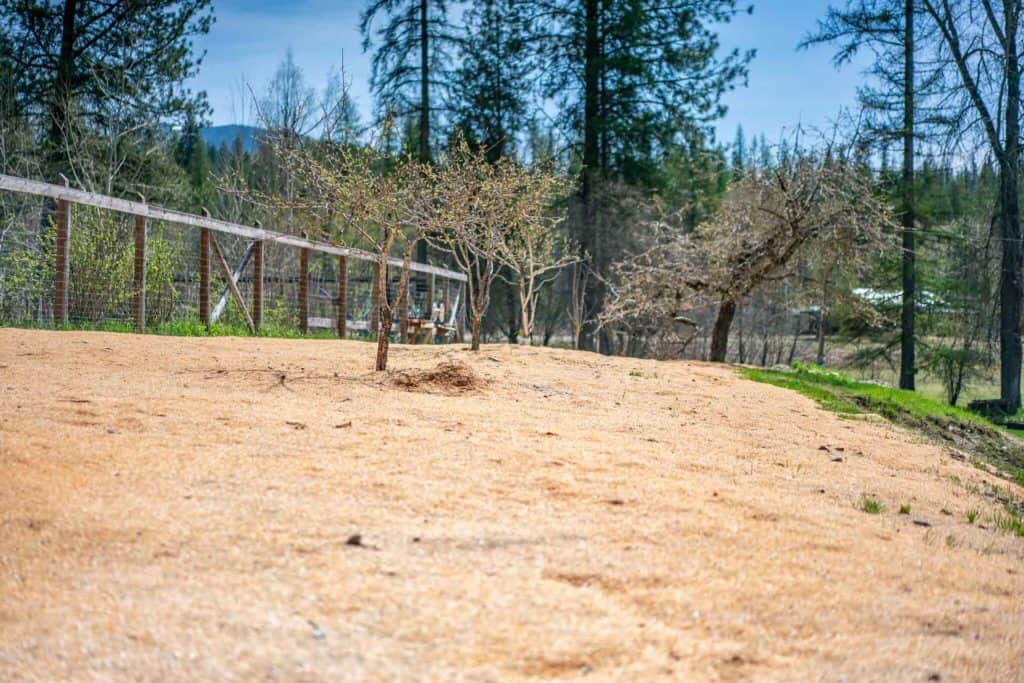
What Priority Should We Give Perennials
You know the saying, “When is the best time to plant a fruit tree? Last year!” However, we all have realities and time constraints. But the general idea is that the sooner you can plant perennials, the sooner you’ll start harvesting.

Types of Perennials
Vegetables
The benefits of growing perennial vegetables are that they tend to bring up a lot of minerals from deep in the ground. This is great for us as we’re coming out of winter where we’re usually eating less nutrient-dense foods and less fresh items.
- Asparagus – We love asparagus because these are some of the first perennials that come up in the spring. Roasted asparagus, asparagus frittata, and asparagus soup are household favorites.
- Dandelion Roots – Another great source of nutrition early in the spring and one of the first things to bloom as the days get longer. Dandelion has many uses on the homestead.
- Sorrel – We already see our sorrel coming up, and there’s still snow on the ground! We couldn’t even be sowing spinach right now because it’s still too cold. Sorrel sauce is the perfect companion for your spring dishes.
- Good King Henry
- Artichokes
- Caucasian Mountain Spinach
- Mushrooms – While technically not a vegetable, some mushroom varieties you can grow at home will produce for up to nine years.

Berries
The benefits of growing berry bushes are that they generally fruit much earlier than your other fruit-bearing trees. They don’t take up a large amount of space, nor do they have the canopy that typical fruit trees have. Some berry bushes can even work well as a hedge in your yard.
- Raspberries
- Blackberries
- Blueberries
- Honey Berries
- Elderberries
- Currants
- Grapes

Fruit & Nut Trees
What would the world be without fruit and nut trees? Depending on where you live, you have a wide variety of options when it comes to fruit and nut trees. These kinds of trees are great to tuck into the landscape for food-producing and shade-producing perennials.
Even if you don’t consume all the harvest from your trees, consider what else can be sustained from the fruit or nuts from your trees. Do you have livestock that you can supplement their food with your excess apples? This is a great option for creating more financial resiliency on the homestead.
Furthermore, if you’re raising those animals underneath the tree, the tree is feeding the animals, the animals are fertilizing the tree, and you’re creating a great system.
There are too many fruit and nut trees to list (far too many for a blog post), but we’ll just cover a few:
- Apple, Pear, Peach, Cherry and Avocado Trees
- Hazelnut (Filbert), Almond, Chestnut and Walnut Trees

Culinary & Medicinal Herbs
There are generally a lot of crossover plants that work as both culinary and medicinal herbs. Many of your culinary herbs are perennial. Not only are they high in nutrition, but in a survival situation, if I’m going to have to eat beans and rice for every meal, having some herbs to season the food with will be incredible.
- Oregano
- Rosemary
- Thyme
- Savory
- Tarragon
Beyond the culinary herbs are your medicinal herbs. When you can grow a perennial medicinal herb you essentially are creating a pharmacy in your backyard. Perennial medicinal herbs also generally flower and are beautiful to grow. So, if you find yourself living in an area where you don’t have the space to grow a vegetable garden, medicinal herbs could be a great alternative for you to grow.
- Elecampane
- Echinacea
- Mint
- Catnip
- Hyssop
- Lavender
Know Your Zone
Before you purchase a perennial plant, make sure it will work in your climate or zone. If you don’t know what zone you live in, you can find out your USDA Hardiness Zone here. Type in your zipcode and it will tell you your general zone.

Perennial Care & Maintenance
For the best self-sufficiency for your perennials, you want to focus on growing items that work well in your zone. You don’t want to have to baby these plants if they’re your insurance policy for food.
Before planting your perennials, you may want to prepare the area with the lasagna gardening method, as we demonstrate with our cottage garden. This will help suppress the weeds and help the plants to get established a bit more quickly.
Each year, you may want to amend with a bit more soil and/or compost until you have a well-established area that’s healthy and productive each year.
Growing perennials means building resiliency, creating habitats for creatures and helping feed the bees. It’s something we’re very passionate about here at Riverbend as we develop our property.

More Posts You May Enjoy
- Strategies for Extending the Gardening Season
- Carolyn’s Cottage Garden Herb List
- Spring Garden Planning Ideas, Tips & Tricks
- Garden Planning for Serious Food Production
- How to Use a Vegetable Garden Planner
- 10 Common Gardening Mistakes to Avoid
- Garden Watering Strategies (How Much, How Often, When)
- Crops That Will NOT Survive a Frost (Non-Hardy-Vegetables)
Josh: Hey you guys. This is Josh.
Carolyn: And Carolyn.
Josh: With Homesteading Family and welcome to this week's episode of The Pantry Chat Food for Thought.
Carolyn: This week we're talking about something that Josh and I really take seriously around here, and that is growing perennials on your homestead.
Josh: Perennials.
Carolyn: Perennials.
Josh: Wow. What are perennials and what do you do with them?
Carolyn: Yeah. Well, we're going to be getting into that in today's Pantry Chat so keep listening. But first we have to have some chit-chat.
Josh: And the question or two of the day from our subscribers.
Carolyn: Absolutely.
Josh: So what's up? What's going on with you here in late winter in North Idaho?
Carolyn: Yeah. Well, I think this is a very weird year weather wise. Maybe every year is a weird year, but this year is particularly strange.
Josh: It's definitely way out of the norm for us.
Carolyn: Yes.
Josh: Yeah.
Carolyn: We were pretty much thinking we were coming out of winter and didn't really have a whole lot of winter and then all of a sudden now we're back into winter and it's just confusing. But all of the wet, the rain and melt and snow and all of these cycles that we keep having has made a lot of moisture and is making a few things a little bit difficult. One of which was we had the whole basement flood, which was kind of fun.
Josh: You had to remind me.
Carolyn: Sorry. Which meant-
Josh: On a Sunday morning.
Carolyn: On a Sunday morning. Yeah.
Josh: You don't get to pick when these things happen.
Carolyn: Which actually I've got to say is a net benefit for us because one, we already have everything pretty much up off the ground in the basement. And when I'm saying flooding, I mean a little bit of water. I don't mean like feet of water.
Josh: It was an inch, but nonetheless, not everything was off the ground.
Carolyn: Most things were off the ground, but it was a disaster and it caused a lot of scramble for about 24 hours, I'd say. But we are working right now at increasing our storage space in our downstairs pantry down in the basement. And that actually caused us to do a whole bunch of prep work on that. So it was nice in the long run. It's not what we would've chosen to do on a Sunday morning, but instead of something taking a couple of us maybe weeks to get done, we just all pitched in and got it done in a day.
Josh: Banged it out because you had to.
Carolyn: Because you had to.
Josh: Necessity gets things done. And by increasing what she means is organizing. We're not adding to the basement space, but reorganizing the space to create ... To actually increase what we can store. The storage.
Carolyn: The pantry storage is what I what mean.
Josh: Right. But it's going to be really cool adding some of the shelves that we already have. So that gave us a little kick along and boosted that project ahead a little bit while inadvertently getting some cleaning done.
Carolyn: We're definitely cleaner. Yep. How about you? What have you been up to aside from vacuuming water out of the basement?
Josh: Wow. Just getting ready, planning projects, thinking about projects this year. And we've done our wish list and our prioritization list, and so starting to plan how those are going to happen, when. I was starting to think I was going to do a few things outside with the way it's been melting and warmer weather and now we have four inches set in last night and a bit more coming, so a little bit of a yo-yo here on the-
Carolyn: That's a good way to say it.
Josh: You think you're going to go, oh, nope. Not going to go. So we'll see how it goes. But reality is we'll probably be planting on schedule like we usually do and just getting the projects in the spring. So really just a lot of planning. Getting ready for that, getting geared up, getting antsy feet.
Carolyn: Yeah. Yeah. We're ready for sunshine. That's for sure.
Josh: Absolutely. Yep.
Carolyn: For soil on my fingers. Sounds so nice.
Josh: Sounds good. Cool. Well, we better move along today. Oh, we need to talk to you all about Lehman's.
Carolyn: Yeah. Lehman's is sponsoring today's podcast, so yay for Lehman's. Which is really exciting for us because we have been shopping at Lehman's for over 20 years.
Josh: Long time.
Carolyn: Long, long time. And I remember the first time I got a Lehman's catalog. If you guys have never seen it. Lehman's was founded back in 1955 to serve the local Amish population. So it's got these great products that you just can't find in other places. Really geared towards off grid living and solutions. But now they're really not only serving their local Amish, but shipping to homesteaders like us.
Josh: All over the country. I can't speak to the world, but all over the country with products to help from plant, to plate, to pantry.
Carolyn: Oh, I like that. That's catchy.
Josh: Kind ff catchy. That's why it's a sponsor.
Carolyn: That's why it's a sponsor. So if you guys haven't checked them out, you definitely want to check them out. Make sure at very least you get their catalog because when I first started getting those catalogs, I would keep them in a prominent place and read them like a magazine because it's fascinating.
Josh: Fun to flip through. You get lots of ideas and really good. And you guys, for those of you that are watching this, Lehman's-
Carolyn: Or listening.
Josh: Or listening. Lehman's will give you a discount for 15% off. Use the code that is in the notes below.
Carolyn: If you're not watching or you're not listening, you don't get to use the code. Just saying.
Josh: 1FH5CT. I didn't know if that would really be helpful to you if you're just listening, but there you go. 1FH5CT, all caps. You got it.
Carolyn: There. You got it. All right. Good. Question of the day today.
Josh: Yeah. Let's see here. We got one here for you from Sarah Dick on water glassing eggs. Have you ever hard-boiled your water glassed eggs?
Carolyn: Yes. I have done that. They hard-boil really well or soft-boil really well for about the first several months of storage. But if you start getting into that six months plus they just crack really easily. The shells start to get a little bit more brittle. So try it because the water glassing or liming eggs, the eggs are still aging. So it's not like you're canning them and suspending animation completely. They're still aging. They're just aging much more slowly. And there's a lot of dependency on how fast they age. Really depends a lot on the temperature in your storage area, all the normal things that aging depends on. So I can't give you like a, yeah, they're good until three months exactly, and then you need to do something else with them. So I always say give it a try with an egg or two and see what happens. If it cracks and you don't like the result, then don't do that. They've gotten too old for it. But definitely you have the first several months of storing where they do boil well.
Josh: Very cool.
Carolyn: Yeah. Okay. And a question for you from Melissa Fisher on a garden planner. Does planting a hoop garden using cattle panels reduce the amount of plants you can plant in the garden versus just trellising or string trellises? I have a small space for our garden. We are planning on doing the cattle panel hoop trellis, but now I'm concerned I won't have as many plants in the garden do this space inside needed for a walkway.
Josh: Yeah. Good question. So the DIY hoop house, hoop trellis with cattle panels is a vertical gardening strategy. So in one way it gives you more room. It doesn't take any more space on the ground. It goes into the ground and so it's not utilizing much space in the ground. I can see where your point about the vertical space, because this is a hoop, it's leaning in and over. And so it is going to interfere with your movement and potentially some plant growth alongside it if you're doing a vertical strategy with lower plants around it. So yeah, you got to decide what's best for you. You could take the same cattle panels and just run them vertically if you don't need or want the hoop aspect. What the hoop aspect gives you ... And we're talking just cattle panels, not a DIY hoop house. That becomes a different discussion, which-
Carolyn: Meaning with plastic over it.
Josh: Right. Which if you're in a colder environment, you might want that. But the hoop does give you more space to trellis things like beans. It gives you more area for that vertical to grow up on. But yes, it does lean into your garden bed and so it may give you less vertical space down low for something you're growing. But it doesn't take any more ground space. So it's a matter of what you're growing. What are you growing inside the panel? Do you want it shaded? And there's value to that shade versus just say a vertical panel that's oriented to the sun in a way that you're still allowing the things you're growing down lower to get full sun. So it's more thinking about what do you need? What are you growing?
Carolyn: Do you feel like the way we use them with running tomatoes or cucumbers or green beans on them and then planting around and underneath it, do you think that that is reducing our ability to ... Our planting space underneath it?
Josh: Not really. But again, it depends on what you want. We have a large amount of space. We're actually using it in a way where the beans are shading things like cabbage and Brussels sprouts who don't like the heat as much. That's great for us. If you have a small space that you're trying to maximize and growing food out of, which I think might be Melissa's challenge here, yeah, you might want more just strictly vertical so that you can get other sun-loving plants that don't need as much shade in there and still get the vertical growing aspect. It's a depends answer.
Carolyn: Yeah. Got it.
Josh: Depending on what are your needs.
Carolyn: Yeah. Okay. Great. There's a follow-up question here from Agena saying that she's looking at putting up a tunnel trellis this year for vining crops and was wondering what crops do you grow under your tunnel trellis?
Josh: Wow. Yeah. So we're growing cabbages often.
Carolyn: Kohlrabi.
Josh: Kohlrabi. Brussels sprouts.
Carolyn: Celery.
Josh: Celery. Yep.
Carolyn: Sometimes lettuces in the middle of summer. We've done that in the past.
Josh: Sometimes onions. And this is when we're usually growing beans on the trellis, so the beans are shading what's inside. So again, you have to think of that. We have other places where we're growing, say tomatoes and cucumbers and more sun gets in. They don't completely shade out as much, and so then in there we're often growing peppers.
Carolyn: Lots of peppers.
Josh: Lots of peppers. Onions.
Carolyn: Sometimes melons.
Josh: Sometimes melons. So again, it's the combination? It gets into companion planting a little bit and sunlight versus shade needs and whatnot.
Carolyn: Which may depend on your particular environment. If you're in a really hot place, your vegetables might really want in the middle of the summer ... You might really do well to have something that's shaded.
Josh: Yeah. The beans take the sun on the outside real well, it's easy to harvest them and then like Carolyn's saying, you've got a shady environment that other plants like.
Carolyn: Okay. So we better jump right into our topic of the day today, which is perennial.
Josh: Perennials.
Carolyn: And growing perennials.
Josh: That's right. So first off, what are perennials?
Carolyn: So perennials are plants that you don't have to plant every single year. They come back over and over again from the same rootstock. So they can either be evergreen where they just stay green and growing year round. And some of this is going to depend on your zone. Or they can die all the way back to the ground and then come back the next year. But it's always coming from the same rootstock.
Josh: Right. As opposed to an annual that grows up every year, release a seed and that seed regrows next year, plant completely dies back and your plant regrows from seed.
Carolyn: So some of the different types of perennials that are out there. There's a lot of ornamental perennials. So you'll run into this all over the place in the ornamental gardening world. That's not really our cup of tea particularly. We're really going to be talking about food and medicine specific plants today.
Josh: Right. And why? So let's dive right in here. Annuals have a place. Growing our tomatoes, our corn, all our standard vegetable garden items, those have a place. But perennials have a place on the homestead. A really, really important place. Why would you say that is?
Carolyn: Well, you and I have this theory in life that we should be making things easier for ourselves in the future. Doing things right now that's going to reduce the work on the same projects at least later and in the future. And perennials really fit into that. So for me, that's one of the top reasons to grow perennials is because you do the work now, get them in place, get them established, but then you get food or medicine in the case of some medicinal herbs, you get fruit, you get all these different things for years to come. And so that is one of the top reasons to grow perennials.
Josh: Absolutely. It's food security with less work over time. So say a corn plant, you get a whole lot of kernels on a corn plant and you can eat that corn one season, but then you have to plant the seed to get another corn plant and additional kernels. You take an apple seed or a walnut seed and ... Don't take me too seriously on the seeds.
Carolyn: Don't take an apple seed.
Josh: Right. Don't take an apple seed. But you plant it once you get your rootstock, you plant it once and it grows up. And it takes longer to produce, but then it produces for years and decades and in some cases, like some nut trees, many, many decades. Well even fruit trees, 80 years, sometimes. A hundred years. So planting one time and harvesting for many, many years. That is a very, very good return on investment and it is a very, very good food security program.
Carolyn: One thing I really want to dive into this idea just a little bit. Because we have different reasons why we may want food that just shows up in our yard aside from just wow, wouldn't that be nice just to have food outside. Fruit hanging on the trees. When life gets hard whether that's because maybe you have a personal medical thing that happens or maybe you have a job loss, maybe another pandemic hits. I don't know. When life gets hard though, it is hard to focus on things like gardening and sometimes it's hard to have the time, the energy, the health to actually get out there and deal with your annual garden. And so this is like insurance. This is food insurance. By having those plants that are established and whether you do much with them or not, most of them are going to give you a pretty decent harvest year after year, even if you don't have the time to get out there and do a whole lot of work on that.
Josh: And you can actually, depending on where you live, get a pretty decently rounded food supply.
Carolyn: You really can.
Josh: Fruits, nuts. There are leafy greens.
Carolyn: Mm-hmm. Different vegetables. We're talking asparagus.
Josh: Different vegetables. Right. So you can really round out your food supply very, very nicely with a selection of perennials that grow in your area.
Carolyn: Now I was thinking of another one, and this one's a little like ... We try to stay away from too much fear mongering or anything like that, but I think this is a reason to grow perennials that should be at least touched on. They don't look like a vegetable garden. So if you have the government ... Or maybe this is even just because you live in a suburb and they don't like vegetable gardens in your backyard in some homeowners association. You perennial plants rarely look like a traditional vegetable garden. They're not as identifiable as a food source. So if you have somebody else eyeing your food source and either not liking it or wanting to harvest it for you or whatever the case may be, the perennials oftentimes they skirt the edges a little bit. They don't quite look like what you'd expect a garden to look like.
Josh: How about if you're stuck in one of those pesky HOAs that don't want you to have vegetable gardens. But trees, ornamentals, a lot of those can be your food. Absolutely. Yeah.
Carolyn: Totally. Good.
Josh: So when buying a new homestead or looking at property, should perennials be one of our first considerations?
Carolyn: There's practicality. You have to have somewhere to move into. We realize that.
Josh: Yeah. It's nice. It's great if they do and it's certainly something to look for. I wouldn't say it's a must have because you can put them in.
Carolyn: But the sooner you put them in, the sooner you start reaping the reward of having food that's out in your yard all the time.
Josh: Well, and when is the best time to plant a fruit tree?
Carolyn: Yesterday. Last year.
Josh: Last year. Right. Last year. Right.
Carolyn: It took me a second. I got it.
Josh: Yesterday. Last year. Right. And fruit tree is the example of perennials. There's lots of different ones. But the sooner you can get these in, the better They are a solid investment. They're not very expensive and you want to get these in. So let's talk about different types of perennials that we would use for food supply.
Carolyn: Okay. Well, right off the top, the one that I'm looking forward to this year is asparagus and rhubarb. Those are two of the early spring ones that we're going to be looking at coming out really soon here. And something really interesting about those early spring perennials, most perennials in fact is they have a much deeper root system than your regular annuals. And so they really get down way down into your soil and they mine a lot of the minerals that have gotten way down in there have been washed down by watering or rain or whatever, what have you. And they bring those back up in their tap roots and they get them back into their leaves. And so it's amazing to me that these great things that we have coming up first thing in the spring are so mineral rich. Right after we've had a winter of maybe eating off of pantry storage, maybe it's not as fully nutrient dense by the time we're getting around to late spring.
Josh: It's been canned. It's whatever it's been.
Carolyn: And so it's like this tonic plant that you have. That would be true of some things that we don't talk about a lot, but like dandelion roots.
Josh: What we consider weeds. Yeah. A whole nother discussion, but yeah.
Carolyn: Sorrel is a great perennial green that comes up first thing in the spring. I actually already have sorrel leaves up and little baby leaves right now and there's snow on the ground. So I could not even be putting spinach seeds into the ground and I could go out and get a few little sorrel leaves. And so those early spring ones are really bring up that real nutritional punch.
Josh: Right. So you've got some vegetables, artichoke's another one.
Carolyn: Oh, yeah.
Josh: You have leafy greens like sorrel. Good King Henry.
Carolyn: Mm-hmm. Caucasian Mountain Spinach.
Josh: Right.
Carolyn: If you live in warmer zones, there's actually a whole slew of different greens that you can grow that are perennial. There's rocket, there's a couple other ones. We don't grow in those zones, so I don't know them as well.
Josh: Right. Then we get into maybe bushes and fruiting bushes. Raspberries, blackberries.
Carolyn: That's the first thing that comes to mind. Raspberries.
Josh: Raspberries. Yeah. We have a lot of raspberries. We love them.
Carolyn: Yeah. But we have things ... Blueberries, honeyberries. We grow some honeyberries here on the property. Those are great. Elderberries. So you can start currents. You can just keep grapes for that matter of perennials that you can have on the homestead. And so you've got these great fruits that come back. And one of the benefits of getting those in really early is that they fruit a lot sooner than most of your trees.
Josh: They also don't take a ton of space. They don't have the canopy. They don't take a ton of space to get a pretty good yield.
Carolyn: That's right.
Josh: And some of them you can even do hedges with if you want to.
Carolyn: Yeah.
Josh: Yeah.
Carolyn: That's great.
Josh: Yeah. Moving on up, we get into trees.
Carolyn: Ooh, fruit trees. What would the world be without fruit trees?
Josh: Fruit trees and often overlooked also nut trees. Something that's on our list to do. We had nuts at our last place, we don't hear yet and it's one of the plantings we need to get on with. But fruits and nuts and of course depending where you live, you have a wide variety of options.
Carolyn: Yeah. Definitely. The nuts are really interesting because if you look back through history in different times where societies have experienced a lot of upheaval like wars, a lot of times nut recipes come out of those periods of time. I'm thinking about World War II in Italy right now. And that's where you get so many chestnut recipes because those chestnut trees, they just kept doing their thing. But they're a great source of fat and protein, which is a little hard sometimes to get out of a plant. And so if you have to survive on them, they're a great thing to have on hand.
Josh: Absolutely. They're a great thing to tuck into the landscape as well, regardless of whether you have zoning regulations or HOA regulations or whatever it is. They can be tucked in if you have a larger piece of property. You might have your formal spaces or you might not have room for those, but you can tuck them into the forest and the edges of the forest in places and gives you more growing room and it hides them a little bit. Getting into that food forest idea.
Carolyn: Well, and let's not limit the idea of eating things like fruit and nuts and all these vegetables, just ourselves, right?
Josh: Absolutely.
Carolyn: Because there's a lot of animals, a lot of your livestock that can be fed off of the excess of your fruit. So maybe you don't need for your family five apple trees, but what can you raise under those apple trees that can be fed off of those apples? And then you have a system right there where you've got the tree producing, you've got an animal eating and then fertilizing right below it and it becomes this nice little system right there.
Josh: Yep. Especially pigs, chickens particularly. Even some of your ruminants can enjoy the fruit. Yeah. There is a lot to do there and a lot to look at in those types of systems where you're augmenting not only our food but the animal's food seasonally. Yeah.
Carolyn: Good.
Josh: Very good.
Carolyn: Well, moving on. We've got things like culinary herbs. Culinary herbs and medicinal herbs. A lot of times there's a lot of crossover for the two. Many, many, many of your culinary herbs are perennials. So whether you're talking about rosemary or oregano or thyme, savory tarragons. The list can just keep going. Those are all perennials and they're great to have on hand because if you get into a survival situation and life is hard and you're surviving off of beans and rice, please put some oregano in my beans and rice. Not only that, but they're really high in nutrition.
Josh: Especially when you grow them. The stuff you get on the shelf, most of it is very, very degraded, so you can grow it for nothing and it's more flavorful and more nutrient dense.
Carolyn: And the other side is it's just sitting there out in your yard for when you need it, which is amazing because if you've gone to the grocery store and bought those sad little clam shells of fresh herbs, they are expensive and they're almost always starting to go bad on you. They don't last very long. And so to just have that right outside your door to be able to run out and grab the herbs to be able to season your food is absolutely amazing. But on top of that, you've got the medicinal herbs which kind of have the same thing going on. They're just sitting there waiting for you to need them, which is great. Year after year. It's like a pharmacy out in your yard that is just free after you get them established and on hand. So I really, really recommend getting in some of those medicinal herbs that are perennials, things like Elecampane. That is coming back constantly. Ignatia is up there.
Josh: I was going to say ignatia is a really, really solid one.
Carolyn: Yeah. So you've got a lot of really good ... Your mints, your catnips, your hyssops, things like that are all going to come back over and over again. Lavenders. Horehounds.
Josh: Everybody loves a little lavender.
Carolyn: A lot of those things are coming back over and over and just sitting there waiting for you to need them.
Josh: And what's really cool is particularly with the culinary medicinal herbs, if you're living in that space, that urban space or that place where you don't have a lot of space or people don't want you growing vegetable gardens and annuals and things that are growing up and dying, doing medicinal herbs in culinary herbs is a no-brainer for getting into gardening. They're beautiful, they flower. Perennial, they're low maintenance once you get them going. And you're saving a little bit of money and creating yourself a healthier product, and it's a great entryway into this lifestyle if you feel like you can't really garden, you can't have much of a garden. But these are the things you can do. If you've got a yard, you almost certainly can get in some fruiting bushes or trees somewhere.
Carolyn: Definitely.
Josh: So they're a great way for some people to get started if you can't have an annual vegetable garden.
Carolyn: Absolutely. So let's talk for a moment about care of perennials. Now, this is pretty broad because each plant is going to have its own specific care needs. But can you talk about any general things here that you need to know about caring for your perennials?
Josh: Well, I think if I can go just before caring, you need to find out what works in your area. If you're going to care for it, well, you need to know it's going to grow in your areas. For perennials, you're generally going to go find out your USDA hardiness zone. And that is based on your lowest temperatures. And then you can find what plants will grow in your area and what perennials are appropriate for your area.
Carolyn: For the best self-sufficiency from these perennials, you want to focus on things that grow really, really well in your area and not be pushing your zones because you don't really want to have to baby these.
Josh: Especially getting started.
Carolyn: If they're you're insurance.
Josh: Especially getting started. As you learn a little bit, you can learn to apply microclimate and different principles to stretch the balance a little bit of things you want but don't quite fit in your zone, especially for us cold climate folks where we can warm things up a little bit. But yeah. So you need to make sure you do that because that is going to make the care of your plants much easier if they grow in your particular climate.
Carolyn: Now, if you think about the regular life cycle of a plant that dies back in the winter, whether that's a fruit tree and it drops all of its leaves in the fall, it is going to drop all of its leaves in the winter. And that's going to drop right around the plant, and then over the winter it's going to be breaking down and provide mulch and nutrients back to the plant and the soil.
Josh: Building soil. This is what we try to mimic in our annual gardens.
Carolyn: Which is why we would fertilize. Or what would we do? Compost. What do you usually do for the perennials?
Josh: Well, definitely getting a garden going, getting a perennial garden going, yes, you're going to probably need to do some soil amendments and we would prep it. When we built yours, we prepped it just like we would do an annual garden where we built up the soil, we sheet mulched, we put down cardboard and paper to get rid of the weeds and accelerate a little decomposition, added some compost in and planted. And the first few years you may add a little bit of compost. Really over time, as that gets established, you're probably going to go to a mulch of some sort. The plants are going to self mulch. You may want a little bit more mulch like a wood chip mulch or something. And it shouldn't take a whole lot of input at all because you're developing an ecosystem there where it is dropping the litter. Sometimes you're trimming some of the plants, you can leave those to break down in the soil and you're really having a chance to mimic nature in this circumstance.
Carolyn: I love it. That's like best of all the worlds. All the circumstances. Get it in, get it established, it keeps giving you food and it minimizes your work year over year. It really is a good deal.
Josh: Yeah. It really is. In our society, we've gotten very focused on annual gardens and they're great, and maybe that's because in the grocery store, maybe that's just our nature. But it is so, so easy to overlook the value of perennials. Long-term harvests with low maintenance. You're building soil, you're building a place for bees and healthy habitats. Yeah. It's something we all need to be incorporating.
Carolyn: Now, I can just hear right now people coming and being like, "Yeah, yeah, you make it sound so easy but I have problems year after year with the fruit trees. We have pests that always attack this particular fruit tree." Our answer is the really practical, maybe pragmatic one that people don't like. Grow a different perennial that grows well without a lot of fuss. Like maybe you're growing the wrong thing.
Josh: You may be growing the wrong thing. You may have two limited of a system. Look, if you've got a lawn and one fruit tree, you have a lot of lack of diversity and that opens up that fruit tree for attack as opposed to having lots of different plants. Nature is diverse. Nature doesn't work in mono crops so that would be another part of the answer is doing multiple layers. Look into food foresting. And you'll get a lot of ideas how to put a whole lot of diversity and a whole lot of production into a small space and make it healthy.
Carolyn: If you guys want to dive deeper into this topic, make sure you go check out the blog post that is attached to the description here. We'll make sure to put a link in there. And if you haven't before, go check out Lehman's because I think you'll be really surprised and really enjoy getting to see what they have to offer.
Josh: Absolutely.
Carolyn: It's been good hanging out with you guys.
Josh: We'll see you all soon.
Carolyn: All right. Goodbye.
Josh: Thanks for listening to this episode of the Pantry Chat, Food for Thought. If you've enjoyed this episode, please subscribe, rate, and review
Carolyn: To view the show notes and any other resources mentioned on this episode you can learn more at homesteadingfamily.com/podcast.
Josh: We'll see you soon.
Carolyn: Goodbye.
Sign up to receive email updates
Enter your name and email address below and I'll send you periodic updates about the podcast.



